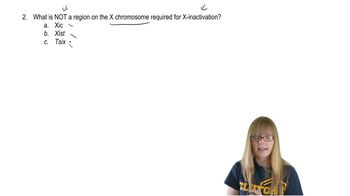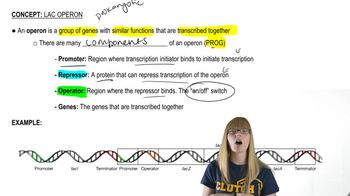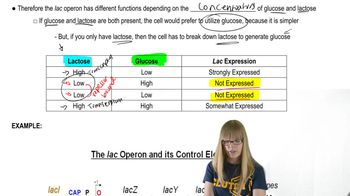Table of contents
- 1. Introduction to Genetics51m
- 2. Mendel's Laws of Inheritance3h 37m
- 3. Extensions to Mendelian Inheritance2h 41m
- 4. Genetic Mapping and Linkage2h 28m
- 5. Genetics of Bacteria and Viruses1h 21m
- 6. Chromosomal Variation1h 48m
- 7. DNA and Chromosome Structure56m
- 8. DNA Replication1h 10m
- 9. Mitosis and Meiosis1h 34m
- 10. Transcription1h 0m
- 11. Translation58m
- 12. Gene Regulation in Prokaryotes1h 19m
- 13. Gene Regulation in Eukaryotes44m
- 14. Genetic Control of Development44m
- 15. Genomes and Genomics1h 50m
- 16. Transposable Elements47m
- 17. Mutation, Repair, and Recombination1h 6m
- 18. Molecular Genetic Tools19m
- 19. Cancer Genetics29m
- 20. Quantitative Genetics1h 26m
- 21. Population Genetics50m
- 22. Evolutionary Genetics29m
12. Gene Regulation in Prokaryotes
Lac Operon
Problem 26
Textbook Question
Suppose that base substitution mutations sufficient to eliminate the function of the operator regions listed below were to occur. For each case, describe how transcription or life cycle would be affected.
lacO mutation in E. coli
 Verified step by step guidance
Verified step by step guidance1
Identify the role of the lacO operator in the lac operon of E. coli. The lacO operator is a DNA sequence that acts as a binding site for the lac repressor protein, which regulates the transcription of the lac operon.
Understand the normal function of the lac operon. In the absence of lactose, the lac repressor binds to the lacO operator, preventing RNA polymerase from transcribing the downstream genes necessary for lactose metabolism.
Consider the effect of a mutation in the lacO operator that eliminates its function. If the operator is mutated, the lac repressor cannot bind to it, leading to constitutive expression of the lac operon genes, regardless of the presence or absence of lactose.
Predict the consequences of constitutive expression of the lac operon. The genes for lactose metabolism (lacZ, lacY, and lacA) would be continuously transcribed and translated, potentially wasting cellular resources when lactose is not present.
Reflect on the broader implications for the cell's life cycle. Continuous expression of the lac operon could affect the cell's energy balance and resource allocation, potentially impacting growth and survival in environments where lactose is absent.
Recommended similar problem, with video answer:
 Verified Solution
Verified SolutionThis video solution was recommended by our tutors as helpful for the problem above
Video duration:
3mPlay a video:
Was this helpful?
Key Concepts
Here are the essential concepts you must grasp in order to answer the question correctly.
Operator Regions
Operator regions are specific DNA sequences where regulatory proteins bind to control the transcription of adjacent genes. In prokaryotes like E. coli, the operator is part of operons, which are clusters of genes transcribed together. Mutations in these regions can disrupt the binding of repressor proteins, leading to either constitutive expression or silencing of the genes involved.
Recommended video:
Guided course

Regions of X Chromosomes
Lac Operon
The lac operon is a well-studied example of gene regulation in E. coli, responsible for the metabolism of lactose. It consists of three structural genes (lacZ, lacY, and lacA) and is regulated by the lac repressor, which binds to the operator region (lacO) to inhibit transcription in the absence of lactose. A mutation in lacO can prevent the repressor from binding, resulting in uncontrolled expression of the operon.
Recommended video:
Guided course

Lac Operon Overview
Transcription Regulation
Transcription regulation refers to the mechanisms that control the rate of gene expression by influencing the transcription of specific genes. In bacteria, this often involves the interaction of transcription factors with operator regions. Mutations that affect these interactions can lead to significant changes in the cell's ability to respond to environmental changes, such as the availability of nutrients like lactose.
Recommended video:
Guided course

Eukaryotic Transcription

 4:27m
4:27mWatch next
Master Lac Operon Overview with a bite sized video explanation from Kylia Goodner
Start learning


